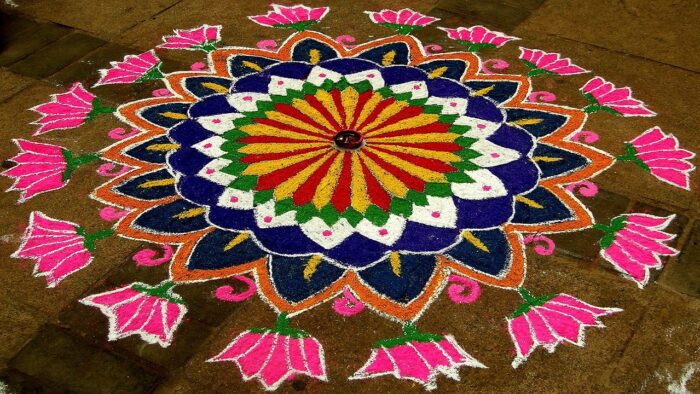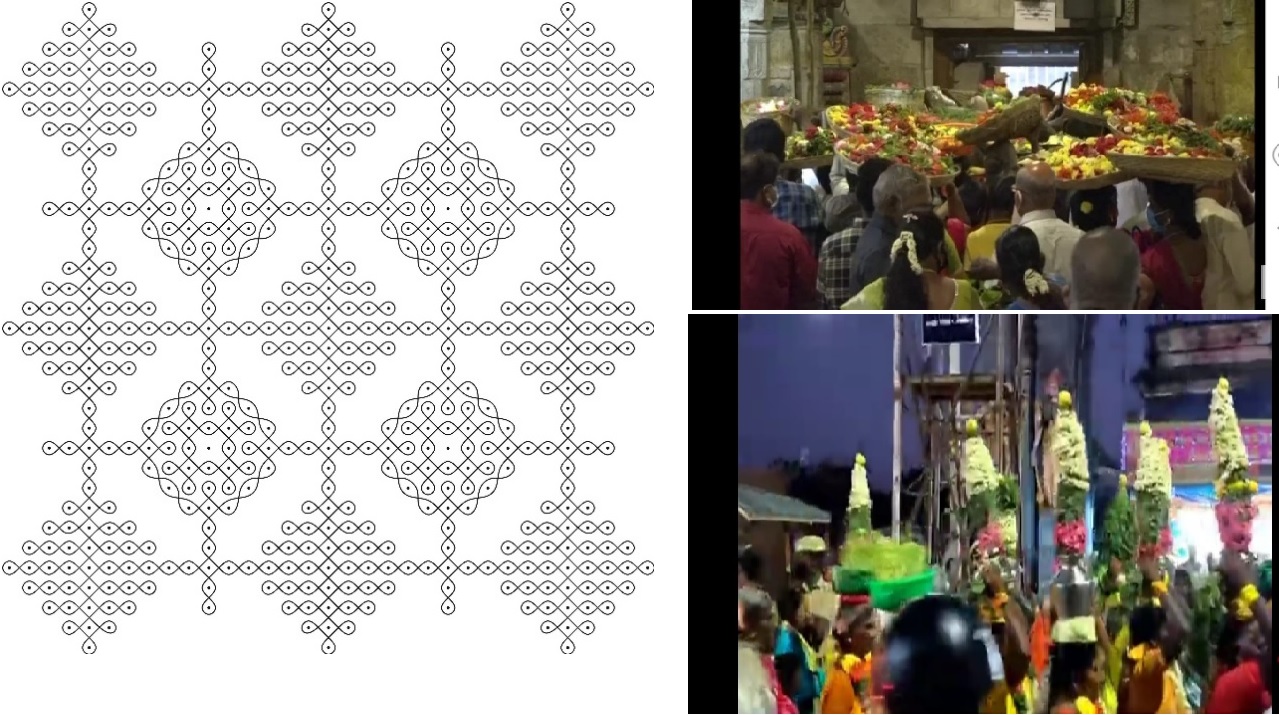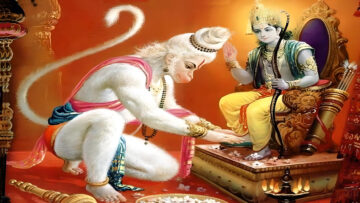“Indian thought takes a comprehensive view of art. The Indian artist is free to take any aspect of the whole creation for his field. The principal aim of the artist is to produce a work which has a flavour (rasa). The work of the artist is full of rasa when it satisfies the craving for order, harmony, balance, rhythm, and pattern. Indian aesthetic theory has recognised all the aspects of art. It recognises the appeal of the medium, the artistic qualities of brightness, sweetness, and vigour.”- Ananda Coomaraswamy
Ancient texts that talk about floor art and paintings are Vishnudharmottara, Abhilashitartha Chintamani of King Someswara III 12 century and the Silparatna of Srikumara 16 century details Dhulichitra and Rasachitra. They are Chitras, images or paintings, drawings executed with dry and wet powders or paste on floors and walls.
Naradashilpa also details Bhaumika, which corresponds to the Dhulichitra of Abhilashitartha Chintamani.
The word Kolam means beauty, grace and form. It is a daily ritual practised by the women and young girls of Tamilnadu for centuries. They are visual symphonies that are in harmony with the universe.
Kolams can be traced to the Sangam era. The ancient Tamils have classified five-fold geographical divisions of Tamil Nadu as Ainthinai. Accordingly, the hilly region is called as Kurinji, the forest area as Mullai, the dry regions as Palai, the cultivable region is Marudam and the areas lying adjacent to seas are Neithal. Kurunji, Mullai, Palai, Marudham and Neithal are all flowers.
The current version of Kolam practice has its early mention in Andal’s Nachiyar Thirumozhi according to Meenakshi Devaraj, a Tamil Historian.
Indian flowers have a unique, special, and sacred significance.
According to The Kularnava Tantra, Pushpa or flower increases merit, punya, removes the heap of sin, paapa, yields much wealth, puskalartha and so it is called Pushpa.
There’s a constant exposure to flowers and Kolams through our scriptures, religious rituals, ceremonies, feasts, and festivals. This has had a profound influence on the distinct aesthetic appreciation and sensibilities of the Hindu milieu. Flowers and Kolams play a great role in the emotional refinement that leads to an enhancement of the sense of aesthetics.
FORM AND STRUCTURE OF FLOWERS & KOLAMS
Floral symmetry defines how flowers are divided into mirror-image parts. It can be determined by the position and shape of the perianth.
A flower with radial symmetry e.g., Hibiscus, Datura.
A flower with bilateral symmetry e.g., Pisum, bean, Cassia and Gulmohar.
Asymmetric – a flower cannot be divided into two equal halves along any plane e.g., Canna.

Figure 1: Symmetry in diverse flower shapes. Asymmetrical flowers have no plane of symmetry, whereas bilateral flowers have one and radial flowers have multiple planes of symmetry. If a flower has two planes of symmetry perpendicular to each other, it is sometimes described as bisymmetrical.[1]
Such symmetry is very evident in Kolams too. Below are different examples of Kolams exhibiting different symmetry. Asymmetric Kolams are not drawn.


Figure 2: Radial Symmetry in Kolam
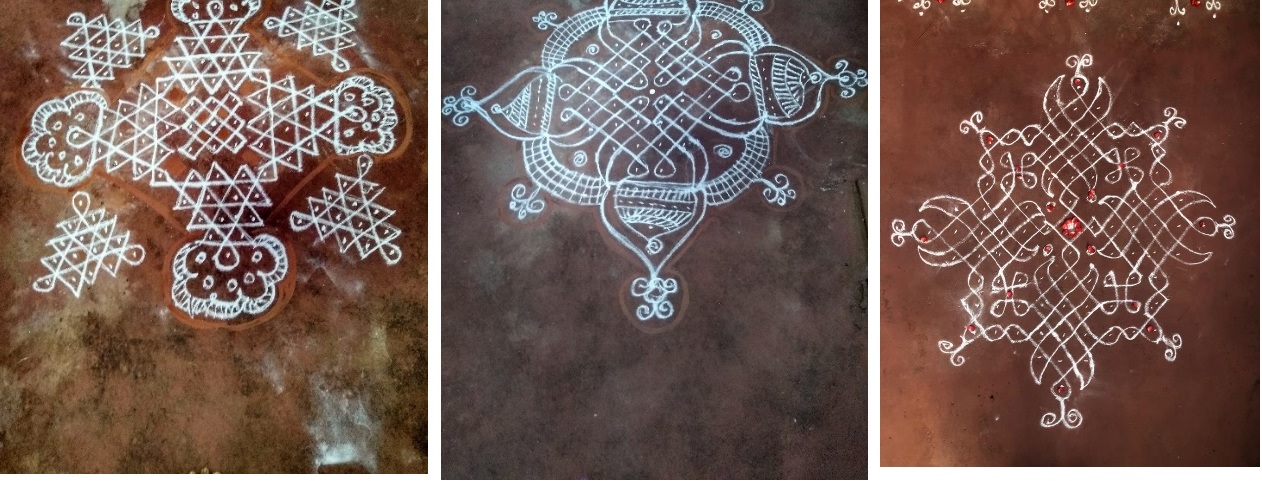
Figure 3: Bisymmetry in Kolam


Figure 4: Bilateral in Kolam
The symmetry, balance, aesthetic appeal, and beauty that is present in flowers lends itself to being incorporated as Kolams in a very organic manner. The visual appeal and the golden proportion principles in both the structure of the flowers and the designs of the Kolams make them an important adjunct to the sacred rituals extending an aesthetic appeal to the rituals and ceremonies.
AUSPICIOUS FLOWERS & KOLAMS
The Rishis of ancient India had a very vast and commendable knowledge of the plant kingdom of India. Their knowledge of the habitat, form, colour, varieties, fragrances, and uses of different flowers are well recorded in our ancient texts and scriptures. A research paper by Shri KG Seshadri on Classification of Flowers as Gleaned from Ancient Indian Literature and Culture presents detailed references to flowers in the Vedas, Ithihaasa and Puranas. Flowers are classified based on petals, their arrangements, stem, influence of the Sun and Moon, sterility and blossoming.
Puṣpa, Sumana or Kusuma refers to “fragrant flowers” and represents one of the various upacārasor offerings, in puja and ritual worship.
Among the many flowers of sacred value are Lotus, Parijat, Ketaki,Champa ,Japa or Hibiscus, Jasmine orMalli, Siris, Nagalinga, Aparajita or ShankhPushpa, Bandhuka, Ixora, Damanaka, flowers of the Banana plant, flowers of the arecanut or Supari and Neem trees.
There are Saatvik, Rajasic and Tamasic flowers, fierce, mild, and powerful flowers and flowers that are acceptable or not acceptable to the different deities.
There are so many myths and legends woven around flowers. Stories of the Parijat tree and flowers, the Ketaki flower and Thumba are ever fragrant.
– Lotus
Lotus is rightly called as the Cosmic flower. It is a symbol of purity and enlightenment.
The lotus signifies that the soul rises from the muddy waters of samsara, blossoms and unfolds its petals of enlightenment. Lotus, lotus ponds, flowers and flower gardens represent metaphysical concepts in tangible forms.
There are more than 50 words in Sanskrit for lotus.
Brahma sprang from Vishnu’s navel seated on a lotus.
Goddess MahaLakshmi, the Goddess of Wealth, Prosperity and all qualities required for sustenance sprang from the Ksheera Sagar during the Samudra Manthan standing on a pink lotus. All her eight forms known as Ashta Lakshmi are also depicted seated or standing on a lotus.
Lakshmi is inseparable from the lotus and so is also called Padma, Padmapriya, Padmamukhi, Padmakshi, Padmahasta, Padmasundari, Padmavati, Padmini, Alamelumanga, Alarmelvalli.
Saraswati or the Goddess of learning and arts, is depicted as seated on a white lotus.
Goddess Parvati when depicted along with Shiva in the Ardhanareeshwar form, holds a blue lotus in her right hand and the other hand hangs loosely by the side. When she is depicted independently, she is shown with four arms, where she holds lotus flowers in two hands.
No other flower has inspired poets, artists, sculptors as much as the lotus flower has.
Padmasana or Lotus position is a cross-legged yoga posture which helps deepen meditation.
We refer to the feet of the deities as Padma Paadam. When a person dies, we say that he or she has attained the Lotus feet of the Bhagwan.
Auspicious Lotus Kolams
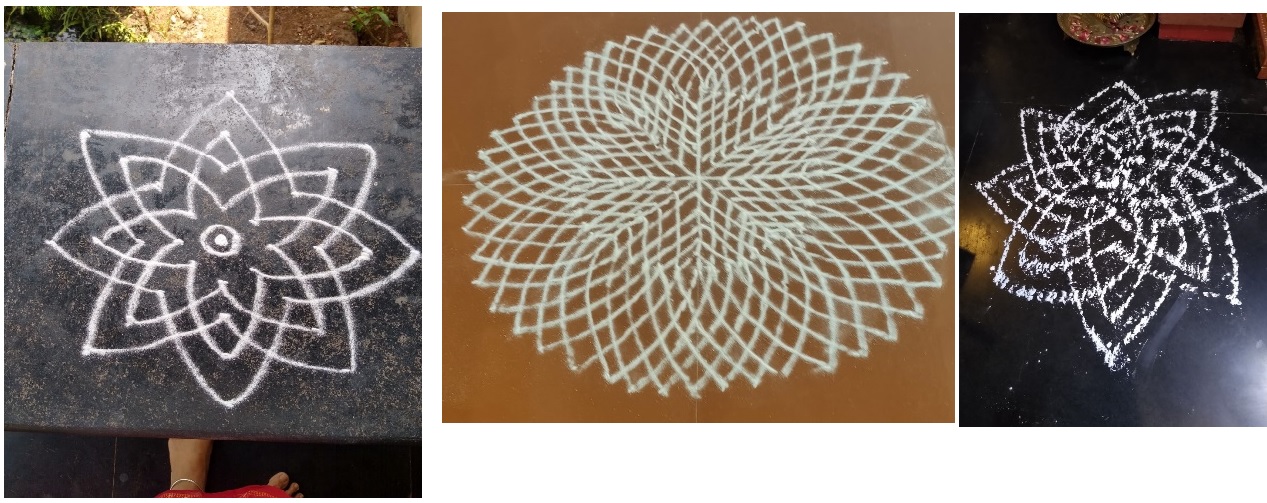
Figure 5:Lotus Kolams – (A) Ashtadalapadma, (B) Sahasradalapadma, (C) Hridyakamala
Hridayakamalamkolam is drawn with a single line that goes through all the dots to form a representation of lotus flower and a lotus of 16 petals is obtained.

Thiskolam is based on dots radiating from the centre towards 8 directions with 45 degrees between the adjacent ones. The pattern uses an arrangement of 5 dots in an arm.
HridayaKamalam symbolizes Goddess Lakshmi. Hence it is also known as Lakshmi Hridaya and Lakshmi HridayaKamalam. Hridaya means heart and Kamala means lotus flower. The lotus is the beloved flower of Goddess Lakshmi.
This Kolamis drawn in Puja rooms on Fridays which is considered significant for Lakshmi worship. This Kolam is not to be drawn at doorways and entrances.
HridayaKamalam is sometimes drawn near theTulasi Vrindavan of a home and on the plank on which Ganesha Puja, Lakshmi Puja and Varalakshmi Vrata Pooja are performed. HridayaKamalam is the Kolam of abundance, well-being and prosperity.
The Sahasrara Chakra is located on the top of the head and is the seat of the Sahasraradalapadma or the thousand-petalled Lotus. When the Thousand Petalled Lotus blooms it is a symbol of complete, unfolding Consciousness.
– Flowers for Navaratri
चन्दनागुरुकर्पूरैःकुसुमैश्चसुगन्धिभिः।
मन्दारकरजाशोकचम्पकैःकरवीरकैः॥२८॥
मालतीब्रह्मकापुष्पैस्तथाबिल्वदलैःशुभैः।
पूजयेज्जगतांधात्रींधूपैर्दीपैर्विधानतः॥२९॥
Candana-Aguru-KarpuuraihKusumaish-Ca Sugandhibhih |
Mandaara-Karaja-Ashoka-CampakaihKaraviirakaih ||28||
Maalatii-Brahmakaa-Pusspais-TathaaBilva-DalaihShubhaih |
Puujayej-JagataamDhaatriimDhuupair-Diipair-Vidhaanatah ||29||
Devi Bhagavatam – Skanda 3 – 26
With Chandana, Agaru, Karpura and fragrant flowers, Mandara, Karaja, Ashoka, Champaka and Karavira, Malati, Brahma flowers as well as auspicious Bilva leaves, The bearer of the Universe should be worshipped with Dhupa (Incense stick) and Deepa (Lamp) as per the ritualistic tradition.
– KAMAKSHI, KAMADEVA, FLOWERS AND KOLAMS
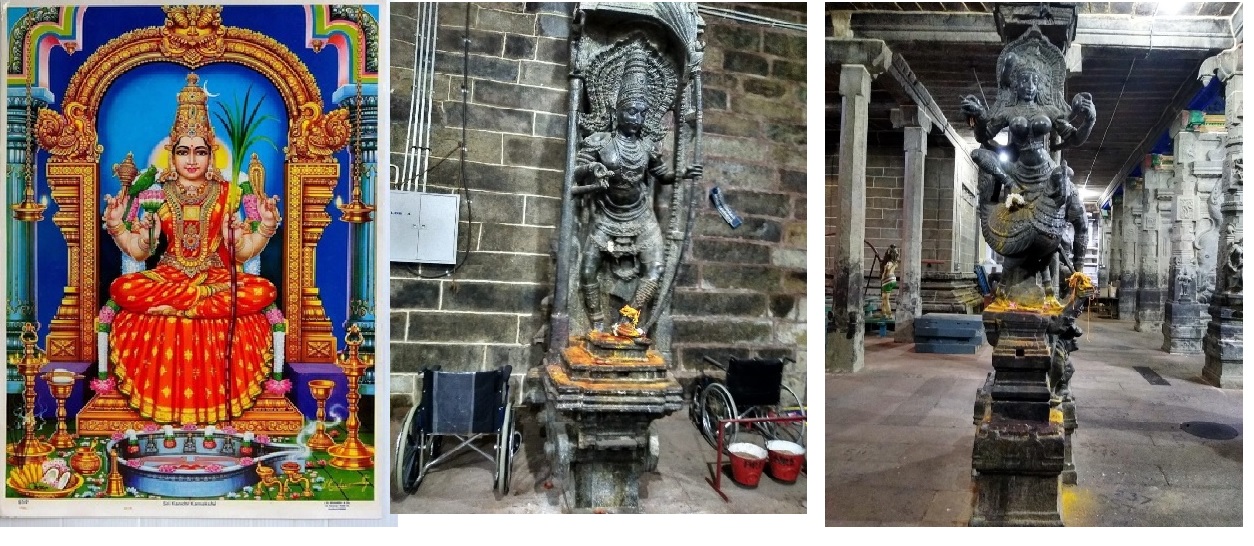
Figure 6:Goddess Kamakshi (left)[2], Manmatha or Kamadeva (center) and his consort Rati (right) in Srivilliputhur Temple, Tamilnadu.
The five arrows of Kamadeva, God of Desire, are five flowers –Aravinda (White Lotus), Ashoka, Chuta (Mango blossoms), Navamallika (Jasmine) and Nilotpala (Blue Lotus).
Puṣpabāṇa (पुष्पबाण) refers to the “five flower-arrows” of Kāma, according to the Śivapurāṇa 2.2.2. O best of sages, when I Brahmā, thought like this, a wonderfully Beautiful Being appeared as my mental creation.
Brahmā said:—“In this form and with your five flower-arrows [viz., Puṣpabāṇa] you can enamour and captivate men and women and carry on the eternal task of creation. In this universe consisting of three worlds, mobile and immobile beings, none of the living beings including the Devas will be competent to defy you. O best of beings, not to speak of ordinary living beings even I Brahmā, Vāsudeva and Śiva will be in your control. Invisibly you enter the hearts of living beings, excite thrilling feelings of pleasure and carry on the activities of creation that is to last forever. The minds of all living beings will become an easy target of your five-flower arrows (Puṣpabāṇa). You will be the cause of their elation. Thus I have assigned you the task of facilitating creation. These sons of mine will confer names and titles on you”.
Taking his five flower-arrows (Puṣpabāṇa), Kāma decided on his future course remaining invisible in form. His five arrows are respectively: Harṣaṇa (delighting), Rocana (appealing), Mohana (deluding), Śoṣaṇa (withering), Māraṇa (killing). Even sages could be deluded and tormented by them.
Manorupekshukodhandapanchatanmatrasayaka from the Lalitha Sahasranama describes the Goddess as She who holds the sugarcane bow representing the mind and She who holds the five tanmatras as the arrows. She holds the sugarcane bow in her left hand and the tanmatras in her right.
Goddess Kamakshi holds five flowers – Lotus, Raktakairava, Kalhara, Indivara and Mango blossoms. They are associated with the five subtle elements, the Tanmatras: shabda, sparsha, rupa, rasa and gandha (elemental sound, touch, form, taste and smell) from which emerges Panchabhutas a set of five gross elements, the basic elements of nature: Space, Air, Fire, Water and Earth or Akash, Vayu, Agni, Apa, Prithvi. She holds the sugarcane bow that represents the mind, which is the support of the five senses.
– BHUKOLAMS – Bhumi and Kolam connect
I have coined the term Bhukolams that expresses the connect between the earth element, Bhumi and kolams.
Kolams are drawn on the thresholds of homes, in puja rooms, in the cooking area of the kitchens, in temples and wedding mandaps inviting Goddess Mahalakshmi. Kolams are also made to keep the negative energies out. When completed, a Kolam becomes a sacred space that contains the divine energy Bhu Devi or Goddess Lakshmi who symbolises the attributes of auspiciousness, abundance, fertility and prosperity.
The Earth as the prime force or energy that provides, nurtures, feeds and protects is revered as a Mother, a truly feminine force. Both women and earth are considered as the life giver, the ones who nurture, feed and protect the offspring.
There exists an organic connect between the earth, the kolams and the woman drawing the Kolams.
सत्यंबृहदृतमुग्रंदीक्षातपोब्रह्मयज्ञःपृथिवींधारयन्ति।
सानोभूतस्यभव्यस्यपत्न्युरुंलोकंपृथिवीनःकृणोतु॥१॥
Satyam Brhad-Rtam-UgramDiikssaaTapo Brahma YajnyahPrthiviimDhaarayanti |
Saa No BhuutasyaBhavayasyaPatny[i]-UrumLokamPrthivii Nah Krnnotu ||1||
This very first verse of the Bhumi Sukhta from the Atharva Veda extolls that Mother Earth is sustained because of Truth, Cosmic laws, Penance and Dharma. This clearly shows that for the physical attributes of the gross earth element such as mountains, rivers, land, to sustain and exist there is a need of the highest virtues to be present and manifested.
Drawing Kolams everyday can be regarded as a daily puja or prayer or even a Likhitjapa.
They also satisfy the nityakarma of Bhuta Yajna, one of the five great sacrifices (pañcamahāyajña) to be performed by a householder, according to Manu.
Bhūtayajña refers to the offering of oblations or sacrifice of a householder to all beings of feeding the gods, creatures and trees. It increases the practice of kindness and consideration towards the social beings.
Kolams are an expression of asking for forgiveness for desecrating the earth through actions of greed and selfish behaviour.
They are an expression of reverence and thanksgiving for all that the Earth provides.
Since senses are the doorways of perception, sensory experiences affect our mental and physical health and well-being. Kolams as aesthetic patterns contribute to positive impressions in the mind.
Through Kolams, simple rituals, symbols and patterns, the women strive to perpetuate and generate the subtler positive energies that are so vital in sustaining the earth element as expounded very significantly in the first verse of the Bhumi Sukta.


Auspicious MaavuKolams done with rice paste by Smt.Lalitha Krishnamoorthy
Kolams are not merely for decorative purposes and are far more than just geometric designs. They are rich in symbolism and sacred meaning and as an expression of a strong desire for spiritual and material wealth.
Kolams capture and represent the microcosm and the macrocosm, all in a simple, serene, aesthetic pattern.
OF ANDAL, FLOWER GARLANDS, MARGHAZI KOLAMS
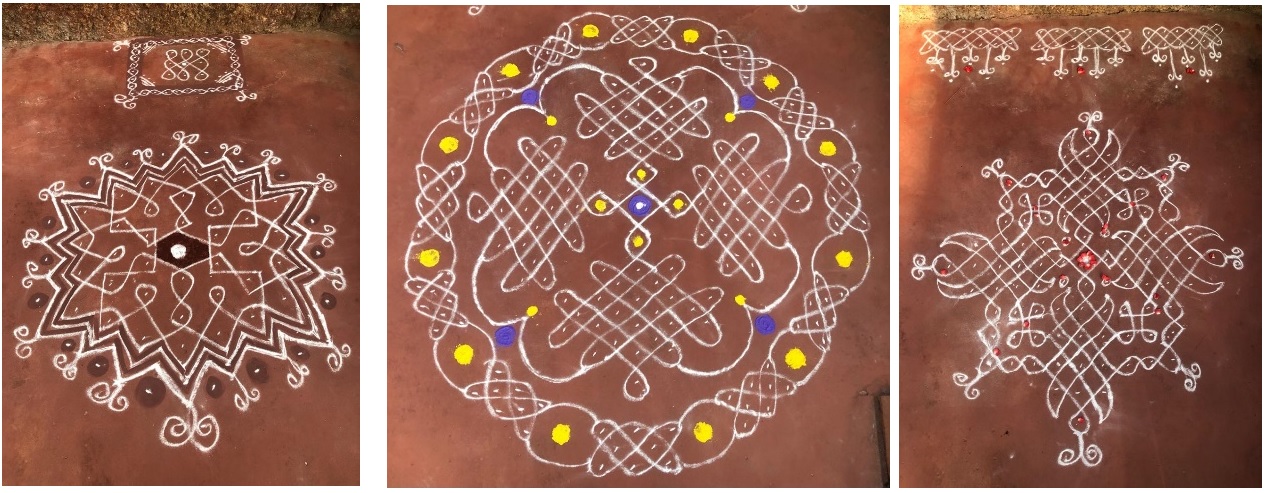
Figure 7: MarghaziKolams


Figure 8: Shri Raman from Srivilliputhur comes from a family that for generations have been hand-crafting Andal’s parrot. The parrot is made with fresh green leaves. A pomegranate flower is used for the beak and mouth.
Andal and Kolams are synonymous with the Marghazi or Mrigasheesh month starting mid December. Andal also known as Godadevi, Nachiyar and Kothai was found byVishnuchitta, the temple priest in the flower garden under a Tulsi plant. He adopted her as his own daughter. Andal is regarded as a reincarnation of Bhu Devi and is the only female Alvar among the 12 Alvar saints of the Vaishnavite sect.
The story of how Andal used to make the flower garlands which were sent to the Vishnu temple in Srivilliputhur and how she used to wear the flower garlands herself before sending them to Sri Vishnu is very well known. She decided that she would marry only Vishnu, Shri Ranganatha of Srirangam.
Sri Vishnu divinely arranged Andal’s wedding with Him. She embraced Him and finally merged with Shri Ranganatha at a very young age of fifteen years.
NachiarTirumozhi is a poem of 143 verses. NachiarTirumozhi means Sacred Sayings of the Goddess composed by Andal expressing her intense longing for Sri Ranganatha.
There are references in these verses to Kolams.
Andal’s compositions called Thiruppavai consists of 30 hymns or Pasurams that are sung starting on the first day of the Marghazi month.
It is a very auspicious month for drawing Kolams. Elaborate Kolams are drawn during the entire month until the beginning of the Pongal festival.
OF PARI, JASMINE AND CHARIOTS
Figure 9:Chariot Kolams are drawn for Rathasapthami for Surya, and for the Tiruvadharai Festival.
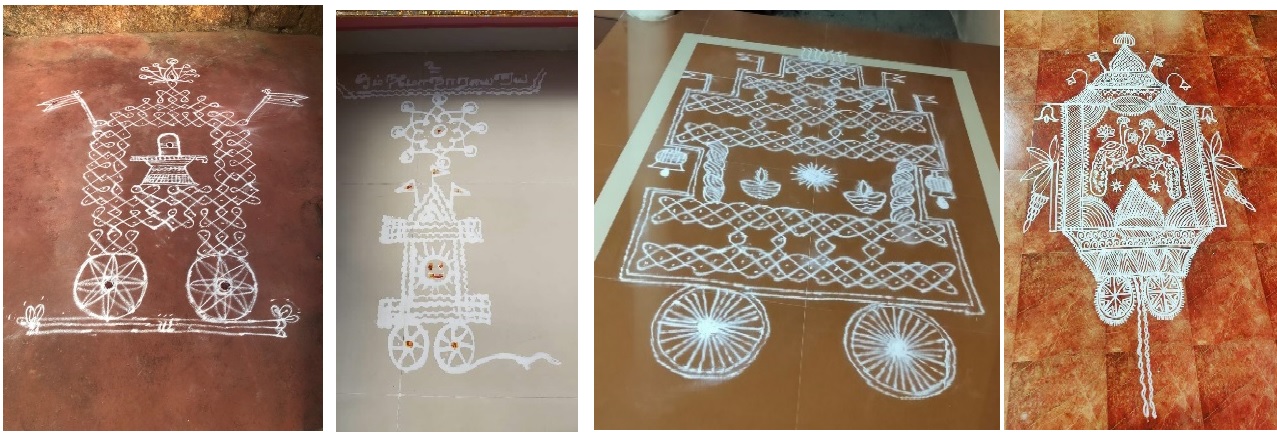
Vēḷ Pari was a ruler of Vēḷir lineage, who ruled Parambu Nadu and surrounding regions in ancient Tamilnadu towards the end of the Sangam era. Pari is extolled for his benevolence, patronage of art and literature.
Pari’s fame is described in Sangam literature as “One who gave his chariot to a climber plant”! He was so generous that he gave away his chariot to a climber plant Mullai, a jasmine variety, when he saw that it was struggling to grow without a suitable support.
Beautiful and elaborate Chariot Kolams are drawn during Rathasaptami and Thiruvadarai or ArudhraDarshan which is celebrated in Chidambaram, Tamilnadu.
OF FLOWER FESTIVALS IN TAMILNADU, FLOWER PALANQUINS, FLOWER CANOPIES AND KOLAMS
Figure 10:(A) Poo Pandal Kolam or Flower Canopy Kolam. (B) Devotees offering flowers at the Poochorithal festival 2021.
Poochorithal or Flower Shower is a famous festival for Mariamman at the Samayapuram temple near Trichy in Tamilnadu. Starting from the last Sunday of the Tamil month of Maasi, the Poochorithal festival is held for 28 days wherein devotees would offer flowers to the deity. Lakhs of people bring bamboo baskets or bamboo trays of flowers for Devi. While it is the tradition and custom for devotees to observe a fast or vrat on a particular day for a particular deity, the unique feature of this festival is that here it is the deity herself who undertakes a fast for the welfare of the world. Pachchai Patni Viradham or Vrat is observed for 28 days when Devi is offered only ThulluMaavu made of pounded rice flour, cardamom and jaggery, tender coconut, buttermilk and fruits and juices.
Madurai is famous for the Meenakshi temple as well as its jasmine flowers.
Madurai’s link with jasmine is well recorded in the Sangam literature and dates back to 300 BC.
The Chithirai festival at Madurai is world famous. It is spread over eleven days starting mid-April. The highlight of the festival is the ThiruKalyanam, the marriage of Shiva and Parvati as Meenakshi and Sundareshwar and is attended by lakhs of people.
The Divine Couple are taken in procession in very elaborately specially designed Poo Pallaaku or Flower Palanquins and chariots.
Flower canopies are strung across the temple to celebrate the joyous occasion.
During festivities and special occasions when the temple deity or the utsavmurthy is taken out in a ceremonial procession, individuals or groups of women quickly adorn the path of the procession with beautiful Kolams. This adds to the ceremonious and sacred atmosphere of the procession.
– Other Flower Festivals
Bathukamma is a floral festival celebrated predominantly in Telangana and some parts of Andhra Pradesh. Every year this festival is celebrated for nine days starting BhadrapadaPournami till Durgashtami, usually in September–October.
The second day after full moon of Bhadrapad month which usually falls between August and September is associated with the Jayanchi Puja of Mardol, Goa. The entire temple is decorated with Jasmine flowers. On the day of Puja, not a single flower vendor will sell a garland or a veni of Jayo to any customer but will utilize these flowers and garlands totally to decorate the various deities of the Mahalasa temple.
Pookalam is an intricate and colourful arrangement of flowers laid on the floor. They are flower carpets made on the occasion of Onam festival in Kerala to welcome the legendary king, Mahabali.
Other flower festivals and major flower shows in India are The Rose festival Chandigarh, Lalbagh Flower Show, Ooty Flower Show, Tulip festival Srinagar, Mysore Dassehra Flower Show, International Flower Festival in Gangtok and the Cherry blossom festival in Shillong.
– Mylapore Festival
Mylapore festival in Chennai is held during the Pongal festival. This festival, held in the vicinity of the Kapaleeshwar temple, Chennai, initially began with the Kolam competition as a standalone event, and over the years, has evolved into a much bigger cultural festival. The festival and the Kolam contest are aimed at spreading the message that the temple and its surrounding areas need to be preserved and promoted as a cultural heritage zone.
ASHTAPUSHPAS
In VatsyaVaradacharya’s PrapannaPaarijaata, the flowers offered represent qualities to be cultivated.
AhimsA prathamam pushpam pushpamindriya nigraha: !
sarvabhUta dayA pushpam kshamA pushpam viSeshata: !!
jnAnam: pushpam tapa: pushpam dhyAnam pushpam tathaiva ca !
Satyam ashtavidham pushpam vishNo: prItikaram bhavet !!
The following eight qualities are very dear to BhagwanVishnu:
- Ahimsa – non-violence in thought, words and action towards all creatures
- Indriyanigrahah – sense control and reigning in the mind
- Sarvabhutadaya – compassion and empathy towards all
- Kshama – forgiveness to all
- Jnanam – knowledge, especially self-knowledge
- Tapas – living a life of austerity
- DyAnam- contemplative meditation
- Satyam – Truth
BRAHMAKAMAL AND BRAHMAMUDI
Brahmakamal holds religious value for devotees of Goddess Nandadevi. It is used for special rituals in Kedarnath temple on the festival of Rakshabandhan. Shekar Pathak, Padmashri awardee, historian and activist said, “The flower has its instance in many spheres of life in the Himalayan states. It holds high religious and medical importance. This flower is the Kohinoor of our Himalayan plant kingdom and should be conserved at any cost.”
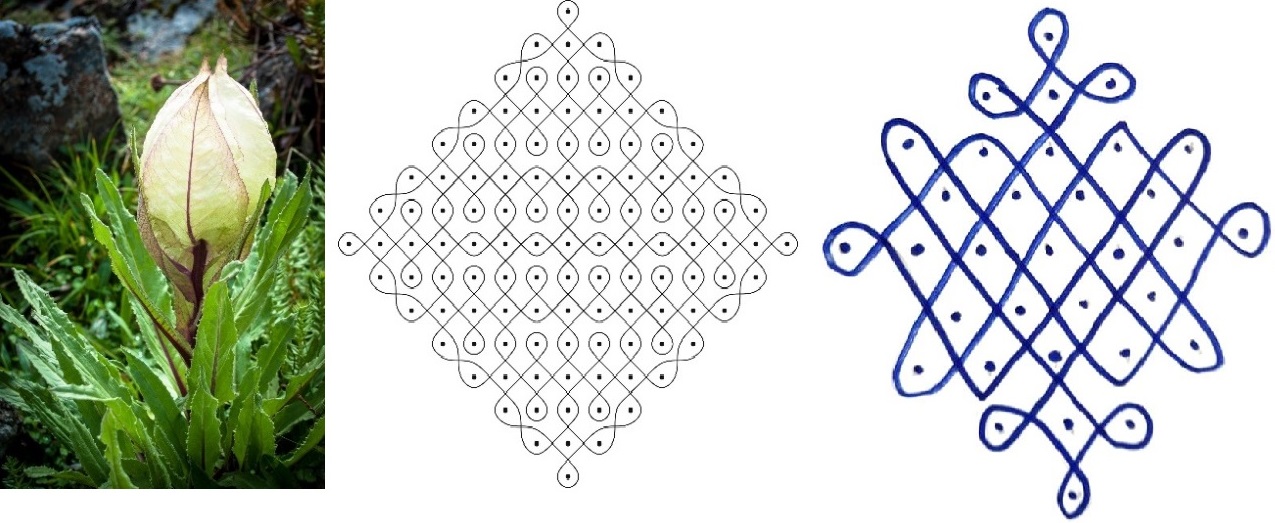
Figure 11:Brahmakamalam, State flower of Uttarakhand & Figure 12: Two variations of BrahmaMudis depicted in Kolams.
Chakras are various focal points used in Tantra practices. There are seven such chakras. Brahma granthi or Brahma Mudi or Brahma’s knot blocks the Muladhara (root) and Svadhisthana (sacral) chakras. This knot is expressed as Kolams.
CELEBRATING TRANSIENCE


Figure 13
That only the soul or Atman is immortal and everything else in this world is transient is the very core of Hindu philosophy.
Flowers and Kolams help one to grasp this philosophy very easily and in fact aid you in celebrating this Transience.
Flowers blossom wilt and wither away in a very short time.
Kolams executed with care and concern are walked over, erased and a fresh one drawn later during the day or the next day.
Dust, wind, breeze, rain may erase or smudge the Kolams, but it is taken in the stride.
Both flowers and Kolams drive home the truth about the impermanence of things and life however beautiful or auspicious they may be.
Conclusion
The diversity and multitude of names and expressions for a flower in the vernacular of various regions, each having its own richness of the significance, sensitivity and importance in the various folklore or sacred rituals is many a time diluted or lost when translated to the English language.
Further there have also been instances where due to the multitude of names and nomenclatures of flowers in different regions – over a period of time there is even confusion in the identification of what was the original sacred flower. The “Brahmakamal” —the state flower of Uttarakhand – belongs to the Sunflower family, whereas in many other parts of India a flower belonging to the Cactus family is considered the “Brahmakamal”.
The locally grown flowers have to face stiff competition from flowers from other countries. Environmental degradation, deforestation, lack of knowledge about our indigenous treasure in the form of trees and medicinal plants are all a serious concern. An awareness about the beauty and utility of our Indian flowers is the need of the hour.
Flower shows in India are gaining popularity and are a tourist attraction. Festivals and competitions in Kolams, garland making, flower arrangement and other allied crafts are also attracting considerable participation. There is good publicity and commercial sponsorships for attractive prizes. While greater number of people involving in these activities is good on one hand, efforts however, should also be made to maintain the sanctity of these rituals and impress upon the participants the higher values and meanings of these rituals.
The rapid change in lifestyles, the influence of technology, and the so-called modernity, has contributed to the dilution and corruption of the essence of the ritual of drawing Kolams in the threshold of one’s abode or in places where sacred rituals are to be performed.
Kolams should not be relegated as mere decorative expression and thereby lose the deeper philosophy and cosmic connect that is the core of this aesthetic ritual practice.
The goal of Sanatana Dharma is Atma Vidya or Knowledge of the Self.
Our scriptures prescribe practices such as devotion to the deities, meditation and service among others as being conducive to advancement towards the goal.
Flowers and Kolams gladden the mind and are facilitators in achieving the goal.
Hindu Aesthetics is in the understanding of the cosmic forces at play, the daily connect with the divinity and the seamless enmeshing of religion and the metaphysical.
Our civilizational culture has shown the grace, elegance, beauty, and refinement of the highest degree in art, literature, music, and other fields.
Only by retaining her Indianness will this spiritual fragrance continue to waft over this land.
– Image Credits
- Figure 1 –Re“CYC”ling Molecular Regulators In The Evolution And Development Of Flower Symmetry – Scientific Figure on ResearchGate. Available from: https://www.researchgate.net/figure/Symmetry-in-diverse-flower-shapes-A-Asymmetrical-flowers-have-no-plane-of-symmetry_fig1_319420540 [accessed 22 Jul, 2021]
- Figure 5 (B) –Sahasradalapadma by Smt.Lalitha Krishnamoorthy.
- Figure 9 (1,3) – Chariots by Smt.Lalitha Krishnamoorthy.
- Figure 11 – Schwiki, CC BY-SA 4.0 <https://creativecommons.org/licenses/by-sa/4.0>, via Wikimedia Commons
– References
- Flowers an Indian Perspective — Tara Kashyap
- Lotus – The Cosmic Flower – Lore, Symbolism, Philosophy and Traditions — P.N. Ravindran
- Madurai Malligal – Madurai and it’s Jasmine — A Celebration — Dr. Uma Kannan
- Shodhganga — Facts of Society in the Manusamhita
- Wisdom Lib
- Plant Myths and Traditions in India – Shakti M Gupta
- Classification of Flowers as Gleaned from Ancient Indian Literature and Culture – Shri KG Seshadri
- Efforts to propagate state flower of Uttarakhand, rare Brahma Kamal and sister species – The New Indian Express – 30th September 2019
- Aesthetics in Indian Art – Anand Coomaraswamy
[1]Re“CYC”ling Molecular Regulators In The Evolution And Development Of Flower Symmetry – Scientific Figure on ResearchGate. Available from: https://www.researchgate.net/figure/Symmetry-in-diverse-flower-shapes-A-Asymmetrical-flowers-have-no-plane-of-symmetry_fig1_319420540 [accessed 22 Jul, 2021]
[2] Image referred from: http://achyuthan.com/sri-kanchi-kamakshi-amman.html
Conference on Hindu Aesthetics
Feature Image credit: wikipedia.org
Watch video presentation of the above paper here:
Disclaimer: The opinions expressed in this article belong to the author. Indic Today is neither responsible nor liable for the accuracy, completeness, suitability, or validity of any information in the article.

